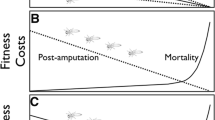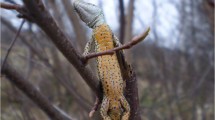Abstract
Damselfly larvae can autotomize their caudal lamellae to escape predation. Costs of caudal lamellae autotomy were investigated by directly manipulating lamellae condition of Lestes sponsa in laboratory experiments. Larvae without lamellae had higher predation mortality in the presence of Notonecta. Both lamellae loss and larval density increased the probability of being cannibalized. The results suggest that the increased vulnerability after lamellae loss resulted from a reduced escape performance. Larvae were less mobile after lamellae loss or in the presence of a predator, but the decrease was no longer significant when both factors were combined. This indicates that larvae compensate for the increased predation risk with a fixed response. Both lamellae loss and predator presence reduced hunting success, but the decrease after lamellae loss was only significant in the absence of a predator. The fitness consequences of these effects for both the larval and adult stages are discussed. In general, the data strongly suggest that lamellae autotomy plays a role in population regulation of damselflies.
Similar content being viewed by others
Author information
Authors and Affiliations
Additional information
Received: 1 April 1998 / Accepted: 28 August 1998
Rights and permissions
About this article
Cite this article
Stoks, R. Effect of lamellae autotomy on survival and foraging success of the damselfly Lestes sponsa (Odonata: Lestidae). Oecologia 117, 443–448 (1998). https://doi.org/10.1007/s004420050679
Issue Date:
DOI: https://doi.org/10.1007/s004420050679




